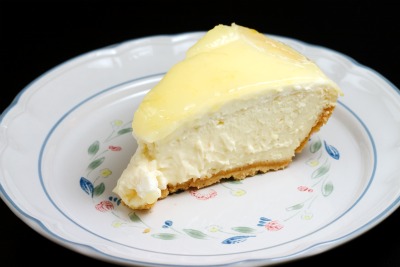|
Cheesecake Tips
These cheesecake tips will make baking cheesecake, transporting cheesecake and even serving cheesecake easier.
Many a cheesecake has been ruined by using cold cream cheese and eggs. For a creamy cheesecake and the best results, make sure all cheesecake ingredients are at room temperature.You can quickly soften cream cheese by placing the unwrapped package of cream cheese in a microwave safe bowl. Microwave for 10 to 15 seconds or just until softened. Add 15 seconds for each additional package of cream cheese. If you are planning to transport your cheesecake to a party, you may want to substitute the springform pan’s bottom insert with a cardboard cake round cut to size and covered in heavy aluminum foil. Cake rounds can be purchased or cut from a large cardboard box. Trim the cardboard to fit snugly into your pan with the foil and bake as usual. Before you leave for the party, remove the rim of the springform pan and place your cheesecake with its disposable insert on a serving plate. No need to worry about misplacing your springform pan insert. Once cheesecake is baked, cool cheesecake slowly on a wire rack away from drafts and at an even temperature for 2-3 hours. Cheesecake should be cooled to room temperature before storing in refrigerator. Run a sharp knife around sides. Leave cheesecake in the pan, cover with plastic wrap and refrigerate for at least 8 hours or overnight. Cheesecake Tips for preventing cracks: Put a pan of water on the bottom rack of the oven when baking cheesecake. The extra moisture will help prevent cracks in your cheesecake. Not all cheesecake receipes get baked at the same temperature. What does matter is that fluctuations in temperature can result in unsightly cracks. Resist the urge to open and close the oven door while baking. It's hard to tell when a cheesecake is done and it shouldn't be over baked either, which again causes cracks. To avoid over baking a cheesecake, check for doneness at the recipe’s minimum baking time, by gently shaking the pan. If the cheesecake is done, the edge should be slightly puffed and it will be set except for a small area in the center that will be soft and wiggly. Do not insert a knife into the center as this may cause the cheesecake to crack during cooling. When all else fails, and a crack appears, there is still hope. Fresh fruit and pie fillings, drizzled chocolate, glaze, graham cracker crumbs or cookie crumbs can be used to cover a crack. Once cut, “garnished” and served, your guests will only notice the delicious taste. Cheesecake Tips for serving: Run a sharp knife around the pan before releasing sides. Carefully slide the cheesecake onto a serving platter or cardboard circle. Using a large, sharp knife, slice the cheesecake by cutting right through it all the way to the plate or cardboard circle. Do not saw through the cheesecake. Rinse the knife off in hot water and dry with a clean towel after each cut. This prevents the creamy filling from building up on the blade, ensuring nice clean cuts that leave the filling intact. Cut only the number of slices you want to serve. This will keep the remainder of the cheesecake moist. Cheesecake Tips for storing: To store leftover cheesecake, wrap tightly in plastic wrap and refrigerate. Uncut cheesecake or slices may be stored in the refrigerator for up to four days. Be sure to wrap tightly as cheesecake may absorb other food odors. To freeze cheesecake, tightly wrap plain, undecorated cheesecake or leftover slices with a double layer of plastic wrap and freeze for 2-3 months. When ready to use, thaw cheesecake in refrigerator overnight or microwave single slices for 15 – 20 seconds. Return to Easy Cheesecake Recipes
|


